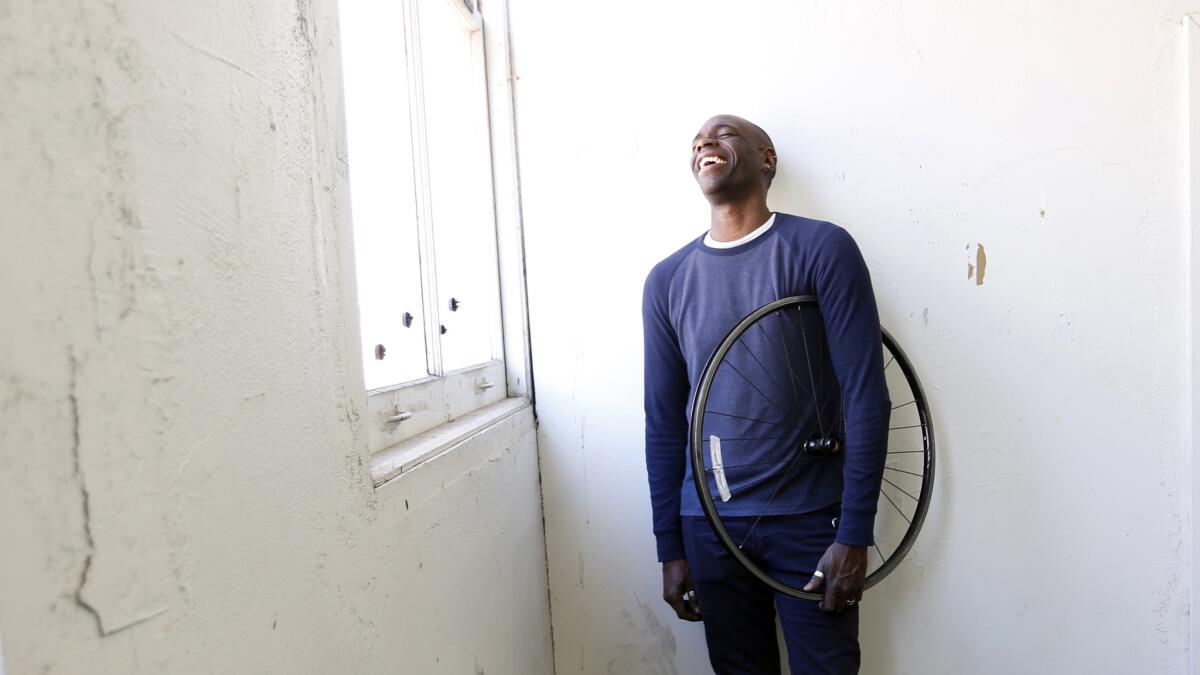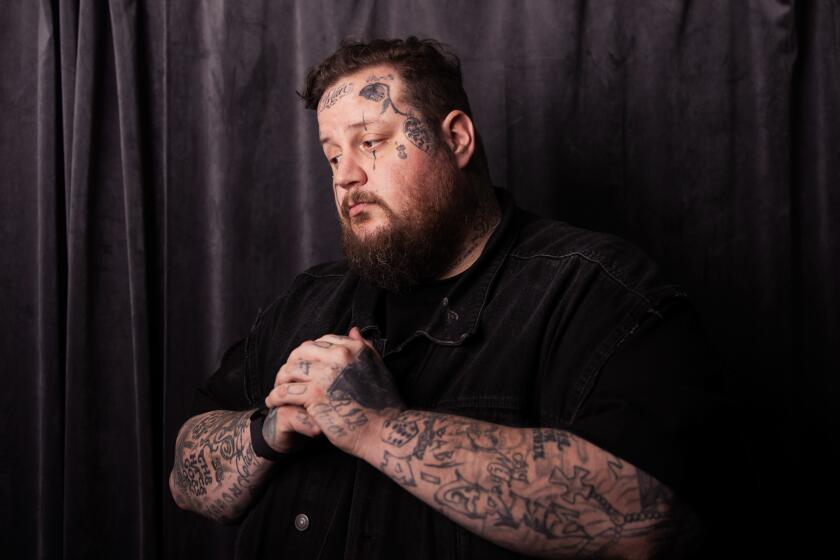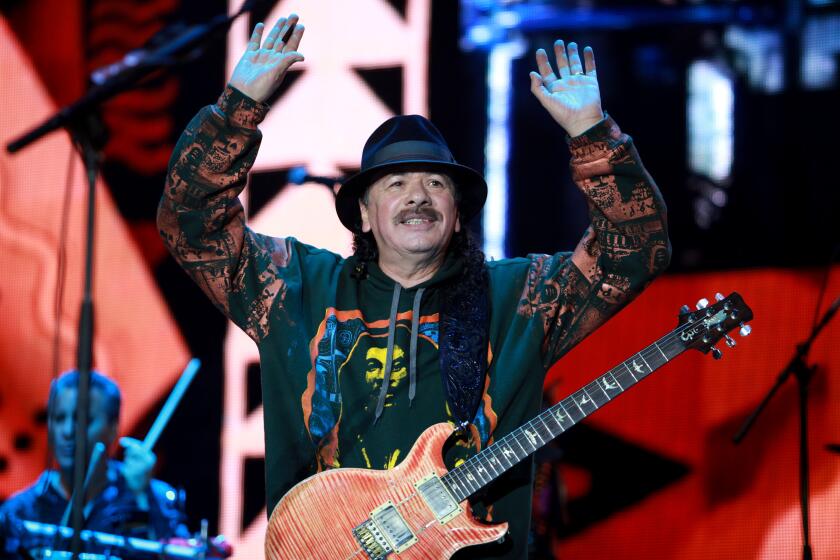Q&A: How Venus Williams, ice skating and pita bread inspire Los Angeles artist Kori Newkirk

Artist Kori Newkirk in his studio in downtown Los Angeles. The longtime L.A. artist has an exhibit of new works on view at Roberts & Tilton in Culver City through Feb. 6.
- Share via
If you’d walked into Kori Newkirk’s sunny studio in downtown Los Angeles late last month, you would have found a wonderland of scavenged bits. Racks of cassette tapes. A tower of brightly colored pool floats. Several dozen bicycle wheels in various states of disassembly. Not to mention a mannequin head dipped in glitter, a pug doll with a jeweled collar and, pinned to one wall, a round of pita bread — evidence of the artist’s ongoing obsession with circles.
“If this were the East Coast, that thing would have sprouted all kinds of mold,” Newkirk said, chuckling. “But this is California. It just dried right out.”
Newkirk was in the midst of preparing for his first Los Angeles exhibition in five years — a one-man show that opened Saturday at Roberts & Tilton in Culver City, where he is showing a series of new sculptural works crafted from the explosion of bicycle wheels carpeting his studio floor. (He was circumspect on what exactly he was making with them: “I don’t like to give too much away before an opening,” he explained.)
The artist first made waves at the now-seminal 2001 exhibition “Freestyle” at the Studio Museum in Harlem. He exhibited a wall painting of a helicopter made out of hair pomade and an elaborate painting-installation piece crafted out of synthetic hair and decorative pony beads, which are often used in braided hairstyles. Since then, his works have been acquired by various museums, including the Hammer Museum and the Museum of Contemporary Art in Los Angeles.
Though Newkirk is from New York, he has lived in Southern California since 1995, when he arrived to go to graduate school at UC Irvine. After receiving his MFA, he moved to downtown Los Angeles, where he has lived in the same loft apartment off Main Street ever since. (“Sometimes it’s shocking to see the changes happen so quickly,” he said of the neighborhood’s recent upscale transformation.) For the last seven years, he has also occupied the same Garment District studio off of Pico Boulevard, tucked above rows of wholesalers dispensing mannequins and reindeer-patterned leggings.
Newkirk took time to chat about how he finds his unusual materials, why he rarely makes the beaded works for which he is best known and how he has watched downtown L.A. evolve.
This is your first solo in L.A. in five years. What took so long?
I don’t know! That’s a good question. [Laughs.] Curators come to my studio. Collectors come. So even though I haven’t had a gallery, I’ve been working. But it does give me more time to think. I’ve never been super concerned with the market. I don’t pander to it. I make what I want. I’ve always taken the long view that this is a marathon.
You’ve been working on pieces that involve circles: tin cans, bicycle wheels and more. Why circles?
I find myself really attracted to circles. I haven’t really questioned it too much. But I think part of it has to do with the fact that I used to be a figure skater. That was mostly high school into college. You had to trace a figure eight on the ice. You had to go through three times and trace the same circle over the same circle. It was really about control and the body. So it goes back to using my body to trace this almost impossible circle over and over and over.
And early in arts training there is always the drawing of circles and ellipses. Can you get that rhythm to do it perfectly? It’s almost a pet peeve when I see it in other people’s work: “Oh, that circle is off! That ellipse is off!” It can make something feel awkward.
And conceptually, there’s the form, the idea that there is no end and no beginning. It’s this continuation of something. Life is a circle. It’s the thought process. I’m trying to tap into all of those things. Geometry. Outer space. The cell. I think of all aspects of what a circle can be.
You’ve worked in a wide range of media over your career: pony beads, photography, video, sculpture, found objects. How do you find and choose your materials?
The idea dictates the material. That being said, I’m constantly looking and searching and grabbing and collecting things that look interesting. I have this box labeled “samples” that has bread ties in it. I have Popsicle sticks I see in the street that have that residue of the Popsicle on it. It’s more interesting to me than an unused Popsicle stick. I like that it’s had a life. I’ll jump in a dumpster in a second if I see something that catches my eye. I have no shame. My mother taught me well.
How did you come to bicycle wheels?
It was off this bicycle I saw in my neighborhood. I find so much inspiration from the Historic Core and skid row. I always think of that as my audience. That’s who I want to make art for. Answers to a lot of my questions about art are already out in the world. So riding around these neighborhoods provides so many answers about how things already exist. I can take that information — a bicycle wheel — and play with it in the studio. I can take it from the real world and manipulate it so that when people see it, they understand it. They can say, “I’ve seen something like that somewhere else.”
How did you arrive at the pony beads?
I think it all came from Venus Williams in 1997 at the U.S. Open. That was the first year. I was stuck in the woods in Maine at an art camp and I was reading the paper. Half of the articles always talked about her hair. And there was stuff about how the other players were afraid that beads would fall off and they’d slip on them on the court. They didn’t know how to talk about them.
That got me thinking about Stevie Wonder in the ‘70s and his hair. I thought of beaded curtains as a doorway. And of the people I’ve known in my life who had beads and braids. I thought, is there a way of making a picture that way? Is there a way to create a picture with hair and beads. It didn’t work out initially, but when I had my first show at Rosamund Felsen [Gallery], I thought, “Let me see if I can figure it out.” And that fueled my practice for a while.
But now you have intentionally moved away from the bead pieces. Why is that?
For a time, everyone wanted them. [My studio] turned almost into a bead factory. I’m sure I could still have someone in the corner making them. People are like, “Send them to Mexico. Send them to China.” But these things are all made by hand and they require adjustments and changes and sometimes all the beads have to come off and you have to pull it apart and start over. And I didn’t want to be the bead boy. There are so many other things that I want to play with and say. So I consciously stopped.
You have been in downtown L.A. since ’97 and have seen the neighborhood’s transition. What has that process been like?
When I moved here, it was getting better, but it was still pretty much a no-man’s land. I didn’t have curtains in my loft because there was no one in any of the buildings around me to see in. It was just about having a place to live and work and it was very inexpensive.
Are you sorry to see that go?
I’m sorry that my rent has gone up. But I do wish it was a little rougher. The rough edges are getting smoothed away and if too much of that happens it becomes a far less interesting place to live. The things that drew me to the neighborhood are leaving. There was dirt. There was neglect. You had all these crazy businesses. The variety — that was interesting.
You’ve probably seen some pretty crazy things.
I don’t know if some of the things I’ve seen can be published in a family newspaper! [Laughs.] Yesterday, I spent the morning looking out my window at a man who was dancing on the sidewalk and he’s telling everyone, “You want to see crazy? Look in the mirror!” And he’s just dancing around and he’s got his headphones on and he’s telling all these hipsters, “Look in the mirror! Look in the mirror! Look in the mirror!” That sort of stuff is really inspiration. It’s the human condition.
“Kori Newkirk” runs through Feb. 6. 5801 Washington Blvd., Culver City, robertsandtilton.com.
Find me on Twitter @cmonstah.
MORE:
Full coverage: Gallery and museum reviews
Apartment stairwell turned into public art gallery? See the latest show for yourself
‘Animal Land’ art project puts vanishing native species in perspective
More to Read
The biggest entertainment stories
Get our big stories about Hollywood, film, television, music, arts, culture and more right in your inbox as soon as they publish.
You may occasionally receive promotional content from the Los Angeles Times.











